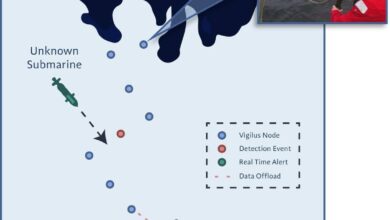The Benefits of Robotic Automation in Offshore Operations – Robotics & Automation News

With the level of workplace hazards in the offshore industry, it’s only reasonable to optimize areas that pose a huge risk to OGE workers. OSHA estimates that from 2015 to 2022 alone, over 2,101 offshore workers were severely injured due to work-related procedures.
These procedures usually involve working under challenging conditions, such as extreme weather, limited accessibility, and hazardous environments, which can pose a massive threat to OGE employees’ health and physical well-being.
And let’s not leave out the consequences for maritime companies. According to The Chopin Law Firm LLC, a group of renowned offshore injury lawyers, companies face staggering costs from workplace accidents, including medical expenses, legal fees, and compensatory damages that can run into millions of dollars while still suffering high operational inefficiencies.
This and many other factors are why maritime companies must prioritize advanced automation and robotics technologies. But before discussing the benefits of this powerful tool to the maritime industry and its work processes, let’s understand how it works.
How Does a Robotic Automation Work?
Robotic automation is the use of machines to handle heavy tasks and operations with little to no human worker involvement.
It’s more like using a nail gun instead of a hammer (the nail gun does the job three times faster, more efficiently, and with little to no odds of you hitting the tip of your fingers in the process).
Depending on the purpose, these robotic machines can range from Remotely Operated Vehicles (ROVs) and Autonomous Underwater vehicles (AUVs) (used for those subsea operations that require precision and efficiency) to robotic arms and manipulators for heavy tasks on offshore platforms and installations.
Nabors Industries, one of the world’s largest oil and gas drilling companies, recently acquired some robotic arms and manipulators (robotic drilling systems).
While they operate the world’s largest land drilling fleet with thousands of employees, you’ll still find them investing huge money in more robotic automation, not just to protect their employees from casualties or improve their work efficiency but also because they know that these investments (though costly now) have tremendous benefits for their business rep and mode of operation.
These benefits include:
Improved Safety and Risk Mitigation
Of course, the primary reason a company like Nabor or any other maritime firm invests in robotic automation for its offshore operations is to protect its employees and mitigate any risks that can cause severe injuries.
Offshore environments can be dangerous to work in because of elements like extreme temperatures, high pressures, and flammable materials.
This is why a maritime company must and should deploy robotic systems that can help reduce human exposure to these sorts of environments. These robotic machines will eventually minimize or even eliminate the risks of accidents, injuries, and potential loss of life for employees.
Research data has also proven this to be true. A recent study done in 2021 to evaluate the effectiveness of adopting robots in automating processes and mitigating workplace injuries showed that an increase in robot exposure actually reduced workplace injuries by approximately 1.2 cases per 100 workers (which is a lot).
Increased Operational Efficiency
And there’s the “efficiency” factor, too. Unlike humans, who occasionally require break periods, a robotic system can work 24/7 without needing breaks or shift changes. This can maximize productivity and reduce operational costs.
And to add to that, robotic automation is best suited for emergency response and disaster management. These systems can be controlled offshore by qualified personnel and quickly deployed in emergencies, such as oil spills or platform evacuations.
They can also be used to evaluate the situation, provide situational awareness, and even assist in containment and cleanup efforts, minimizing the risk to human responders.
Plus, because they are built on the latest artificial intelligence, you can expect these robotic machines to execute any assigned task with the highest precision and consistency (which are huge factors in the offshore industry, where even minor deviations can have significant consequences for operations).
Reduced Cost of Operation and Environmental Impact
The oil and gas business has high overhead costs. Maritime companies will have to pay their employees and provide them with accommodation and transport allowances.
And yet, the result of every employee’s job will be based on their emotions, health, and experience (which all leave room for marginal errors that can disrupt an entire operation).
Robotic automations, on the other hand, are programmed to act as instructed. While they may cost a lot upfront, aside from maintenance, the company can rely on them to be consistent and efficient in handling highly demanding tasks with reduced costs compared to human workers.
Moreover, with the world’s increased focus on environmental conservation and recent reports from the International Energy Agency (IEA) that oil and gas operations account for around 5.1 billion tons of greenhouse gas emissions globally, maritime companies can only rely on these robotic machines to reduce their environmental impact.
Greenhouse gas emissions are primarily due to waste. So, with an efficient robotic automation system in place, resources will be well utilized, reducing the amount of waste produced and even boosting a maritime company’s reputation as a firm that takes proactive steps towards sustainable practices and corporate social responsibility goals.
Challenges in Adopting Robotic Automation
The most obvious challenge in adopting this new technology is mainly the cost. Robotic systems are not cheap. Companies like Open Ocean Robotics that develop these systems use a lot of money, and you surely do not expect them to sell these machines for pennies after development.
So, any maritime company looking to develop, acquire, and implement these advanced robotic systems into its operations must budget for them. It’s a considerable investment, but the long-term operational cost savings and efficiency gains can often offset these initial costs.
Another challenge is maintenance. These machines require frequent maintenance to stay in their optimal form, and in any case, maintaining a robotic automation system will demand some budgeting.
Companies that fail to create a budget for frequently maintaining their systems risk total work disruptions that can affect their business reputation.
So, adopting advanced technologies like these is a more feasible approach for companies that can understand these challenges and create actionable plans to address them.
Wrapping Up
Automation is the new norm, and businesses that fail to incorporate this innovation into their operations will eventually suffer the consequences.
For offshore companies, this involves integrating new technologies like robotic automation systems into their workflow.
Those intelligent enough to leverage this advantage will not only protect their employees and business reputation but also see massive improvements in their work efficiency and productivity.



